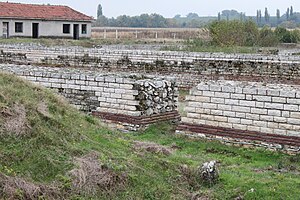Ulpia Oescus
| Colonia Ulpia Oescensium | |
|---|---|

Section of legionary fortress wall, Oescus
|
|
| Known also as | Oescus |
| Founded during the reign of | Trajan |
| Founded | 102 |
| Abandoned | 586 |
| Province | Mesia superiore |
| Limes | Danube |
| — Legions — | |
| Legio V Macedonica da Augusto a Traiano | |
| Coordinates | 43°42′N 24°29′E / 43.700°N 24.483°ECoordinates: 43°42′N 24°29′E / 43.700°N 24.483°E |
| Town | Gigen |
| County | Gulyantsi Municipality |
| State | Pleven District |
| Country | Bulgaria |
Oescus, or Palatiolon Palatiolum, (Bulgarian: Улпия Ескус, pronounced [ul.ˈpi.a ˈɛs.kus]) was an ancient town along the Danube river, in Moesia, northwest of the modern Bulgarian city of Pleven, near the village of Gigen. It is a Daco-Moesian toponym. Ptolemy calls it a Triballian town, but it later became Roman. For a short time, it was linked by a bridge with the ancient city of Sucidava (modern-day Corabia - Romania). The city seems to have at one point reached a size of 280,000 m² and a population of 100,000.
The Greek geographer Claudius Ptolemy (ca. 90-168 AD) described Ulpia Oescus as a city of the Triballi, an independent Ancient Thracian tribe which inhabited today’s Northwest Bulgaria.
The name of the Roman town comes from the river Oescus (today Iskar). It probably meant "water" in the local Thracian dialect.
Under Roman rule, Oescus was important as a Roman settlement and military post, as it protected the Danube Limes road to Philippopolis (Trimontiumto, the modern-day Plovdiv). The city was connected to the rest of the Roman empire by three roads:
The Roman empire's Fifth Macedonian Legion maintained its permanent military encampment at this site from 10 - 101 CE. There are still visible remains of the camp's defensive wall, and areas to the east-northeast (Pyasutsite and Prez Livada) show signs of the presence of a necropolis from this period, containing epigraphic monuments of veterans.
...
Wikipedia

